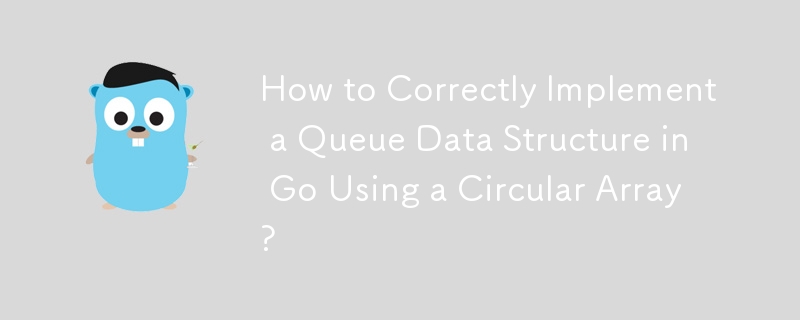如何在Go中使用循环数组正确实现队列数据结构?

Go 中如何实现队列?
背景:
Go 中,标准库缺少队列容器。要实现队列,您可以使用循环数组作为底层数据结构。
初始实现:
提供的代码使用具有以下算法的循环数组:
- 插入: 将 Y 插入队列 X: X[R]
- 删除: 从队列 X 中删除 Y:如果 F = R 则下溢; Y<-X[F]; F
其中F为前,R为后,M为数组长度。
代码与错误输出:
提供的代码实现了这些算法,但输出显示不正确行为:
package main
import (
"fmt"
)
type Queue struct {
len int
head, tail int
q []int
}
func New(n int) *Queue {
return &Queue{n, 0, 0, make([]int, n)}
}
func (p *Queue) Enqueue(x int) bool {
p.q[p.tail] = x
p.tail = (p.tail + 1) % p.len
return p.head != p.tail
}
func (p *Queue) Dequeue() (int, bool) {
if p.head == p.tail {
return 0, false
}
x := p.q[p.head]
p.head = (p.head + 1) % p.len
return x, true
}
func main() {
q := New(10)
for i := 1; i < 13; i++ {
fmt.Println(i, q.Enqueue(i))
}
fmt.Println()
for i := 1; i < 13; i++ {
fmt.Println(q.Dequeue())
}
}Output: 1 true 2 true 3 true 4 true 5 true 6 true 7 true 8 true 9 true 10 false 11 true 12 true 11 true 12 true 0 false 0 false 0 false 0 false 0 false 0 false 0 false 0 false 0 false 0 false
解决方案:
要纠正此问题,需要一个附加字段。修改后的代码合并了一项检查,以确保更新后的尾部位置与头部不重合:
package main
import (
"fmt"
)
type Queue struct {
len int
head, tail int
q []int
}
func New(n int) *Queue {
return &Queue{n, 0, 0, make([]int, n)}
}
func (p *Queue) Enqueue(x int) bool {
p.q[p.tail] = x
ntail := (p.tail + 1) % p.len
ok := false
if ntail != p.head {
p.tail = ntail
ok = true
}
return ok
}
func (p *Queue) Dequeue() (int, bool) {
if p.head == p.tail {
return 0, false
}
x := p.q[p.head]
p.head = (p.head + 1) % p.len
return x, true
}
func main() {
q := New(10)
for i := 1; i < 13; i++ {
fmt.Println(i, q.Enqueue(i))
}
fmt.Println()
for i := 1; i < 13; i++ {
fmt.Println(q.Dequeue())
}
}通过此更正,输出是准确的:
1 true 2 true 3 true 4 true 5 true 6 true 7 true 8 true 9 true 10 true 11 true 12 true 1 2 3 4 5 6 7 8 9 10 11 12
使用切片的替代实现:
在现代 Go 版本中,可以使用更简单的实现slices:
package main
import (
"fmt"
)
// Queue implements a queue using a slice.
type Queue []int
// Enqueue adds an element to the end of the queue.
func (q *Queue) Enqueue(x int) {
*q = append(*q, x)
}
// Dequeue removes and returns the first element of the queue.
func (q *Queue) Dequeue() (int, bool) {
if len(*q) == 0 {
return 0, false
}
x := (*q)[0]
*q = (*q)[1:]
return x, true
}
func main() {
q := Queue{}
for i := 1; i < 13; i++ {
q.Enqueue(i)
}
fmt.Println(q)
for i := 0; i < 12; i++ {
x, _ := q.Dequeue()
fmt.Println(x)
}
}此实现利用了切片的动态增长和垃圾回收,使其既高效又实用。
以上是如何在Go中使用循环数组正确实现队列数据结构?的详细内容。更多信息请关注PHP中文网其他相关文章!

热AI工具

Undresser.AI Undress
人工智能驱动的应用程序,用于创建逼真的裸体照片

AI Clothes Remover
用于从照片中去除衣服的在线人工智能工具。

Undress AI Tool
免费脱衣服图片

Clothoff.io
AI脱衣机

Video Face Swap
使用我们完全免费的人工智能换脸工具轻松在任何视频中换脸!

热门文章

热工具

记事本++7.3.1
好用且免费的代码编辑器

SublimeText3汉化版
中文版,非常好用

禅工作室 13.0.1
功能强大的PHP集成开发环境

Dreamweaver CS6
视觉化网页开发工具

SublimeText3 Mac版
神级代码编辑软件(SublimeText3)
 Golang的目的:建立高效且可扩展的系统
Apr 09, 2025 pm 05:17 PM
Golang的目的:建立高效且可扩展的系统
Apr 09, 2025 pm 05:17 PM
Go语言在构建高效且可扩展的系统中表现出色,其优势包括:1.高性能:编译成机器码,运行速度快;2.并发编程:通过goroutines和channels简化多任务处理;3.简洁性:语法简洁,降低学习和维护成本;4.跨平台:支持跨平台编译,方便部署。
 Golang和C:并发与原始速度
Apr 21, 2025 am 12:16 AM
Golang和C:并发与原始速度
Apr 21, 2025 am 12:16 AM
Golang在并发性上优于C ,而C 在原始速度上优于Golang。1)Golang通过goroutine和channel实现高效并发,适合处理大量并发任务。2)C 通过编译器优化和标准库,提供接近硬件的高性能,适合需要极致优化的应用。
 Golang vs. Python:主要差异和相似之处
Apr 17, 2025 am 12:15 AM
Golang vs. Python:主要差异和相似之处
Apr 17, 2025 am 12:15 AM
Golang和Python各有优势:Golang适合高性能和并发编程,Python适用于数据科学和Web开发。 Golang以其并发模型和高效性能着称,Python则以简洁语法和丰富库生态系统着称。
 Golang vs. Python:性能和可伸缩性
Apr 19, 2025 am 12:18 AM
Golang vs. Python:性能和可伸缩性
Apr 19, 2025 am 12:18 AM
Golang在性能和可扩展性方面优于Python。1)Golang的编译型特性和高效并发模型使其在高并发场景下表现出色。2)Python作为解释型语言,执行速度较慢,但通过工具如Cython可优化性能。
 表演竞赛:Golang vs.C
Apr 16, 2025 am 12:07 AM
表演竞赛:Golang vs.C
Apr 16, 2025 am 12:07 AM
Golang和C 在性能竞赛中的表现各有优势:1)Golang适合高并发和快速开发,2)C 提供更高性能和细粒度控制。选择应基于项目需求和团队技术栈。
 Golang的影响:速度,效率和简单性
Apr 14, 2025 am 12:11 AM
Golang的影响:速度,效率和简单性
Apr 14, 2025 am 12:11 AM
GoimpactsdevelopmentPositationalityThroughSpeed,效率和模拟性。1)速度:gocompilesquicklyandrunseff,ifealforlargeprojects.2)效率:效率:ITScomprehenSevestAndArdArdArdArdArdArdArdArdArdArdArdArdArdArdArdArdArdArdArdArdArdArdArdArdArdArdArdArdArdArdArdArdArdArdArdArdArdArdArdArdEcceSteral Depentencies,增强开发的简单性:3)SimpleflovelmentIcties:3)简单性。
 C和Golang:表演至关重要时
Apr 13, 2025 am 12:11 AM
C和Golang:表演至关重要时
Apr 13, 2025 am 12:11 AM
C 更适合需要直接控制硬件资源和高性能优化的场景,而Golang更适合需要快速开发和高并发处理的场景。1.C 的优势在于其接近硬件的特性和高度的优化能力,适合游戏开发等高性能需求。2.Golang的优势在于其简洁的语法和天然的并发支持,适合高并发服务开发。
 Golang和C:性能的权衡
Apr 17, 2025 am 12:18 AM
Golang和C:性能的权衡
Apr 17, 2025 am 12:18 AM
Golang和C 在性能上的差异主要体现在内存管理、编译优化和运行时效率等方面。1)Golang的垃圾回收机制方便但可能影响性能,2)C 的手动内存管理和编译器优化在递归计算中表现更为高效。






